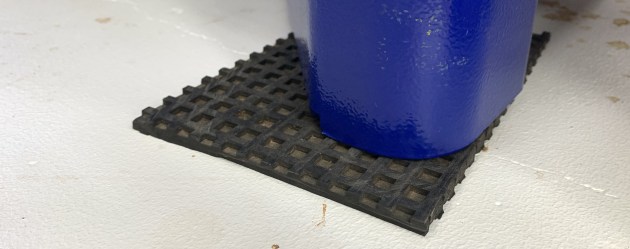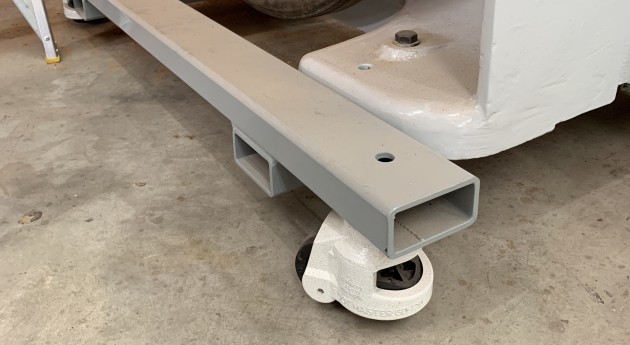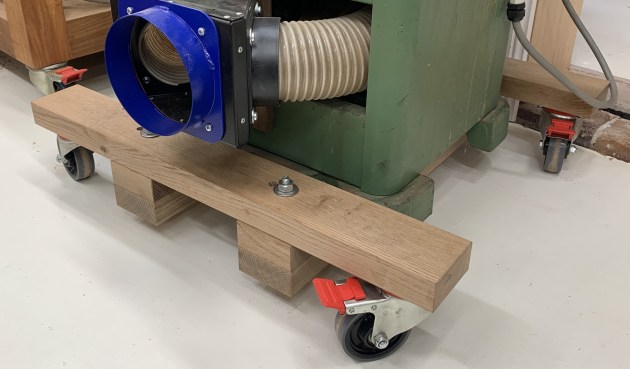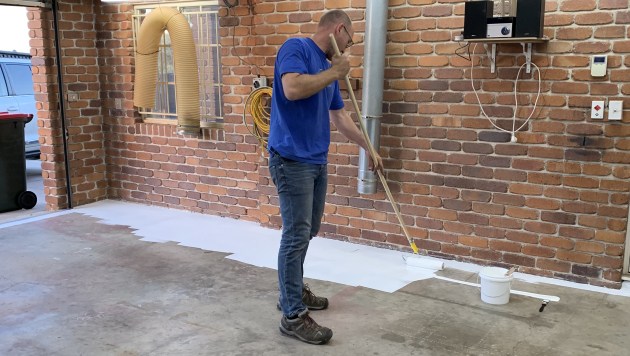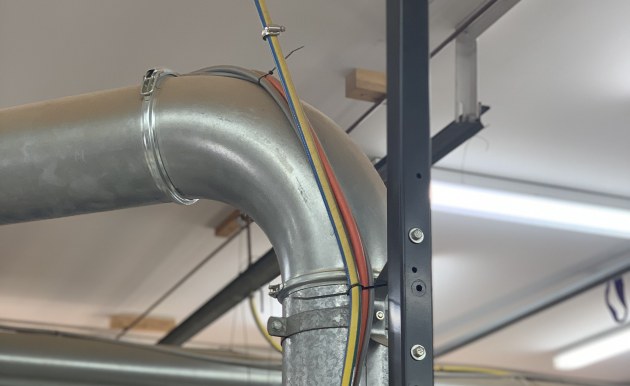Planning ahead for your new machine
Words and photos: David Luckensmeyer
The arrival of a new machine is usually an exciting occasion...but it can also be a costly and stressful exercise. For starters, machines are a significant investment, but there are other costs in time and disruption, as well as set-ups for power, light and dust extraction. If you are thinking about adding another dust or chip maker to your stable, then this article is for you.
Delivery: you or them?
If the seller is organising transport, make sure to ask questions about insurance. When damage occurs the blame game often starts, and knowledge of insurance limitations is advisable.

1. During transport, the best way to protect machinery from rough operators involves the building of a crate.
Smaller and less expensive machinery may be easy enough to move yourself, but as the machine’s weight and
cost rises, so does the liability. Once you take possession of the machine you are responsible for any damage already incurred. In my experience, ‘marine transit’ insurance is inexpensive and worth the cost – this category covers all modes of transport in Australia.

2. A lift point and an endless chain can be very handy for unloading machinery and attaching machine feet or a mobile base.
Be sure to consider the difficulty of access at pick-up or drop-off. For example, are there any restrictive overhead powerlines or trees, narrow roads or steep driveways to consider? If you’re picking up your new machine you’ll need adequate rope and/or straps. Sometimes the machine has to be partially unwrapped so these can be fed through the main chassis, rather than risk damage going over the top.
3. A typical pallet jack has a lifting range of about 150mm, and has a hydraulic arm and a handle that is pumped manually. Most jacks will go as low as 50mm to slide under a machine. The narrow fork version is most useful.
Take care with top-heavy drill presses and bandsaws. Unless a bandsaw has a lifting ring on top, it should be lifted and strapped down by the lower half only, or placed on its spine. Once the machine makes it to the shop floor, a pallet jack is handy for moving items with ease.
4. Industrial quality anti-vibration matting can be purchased in small quantities and cut to size as an inexpensive, low-rise option for machine ‘feet’.
Wraps-off, rust-off
The next phase involves removing packaging and putting the machine on the correct footing. Machines are generally shipped with a rust- preventative, most often VCI paper (volatile corrosion inhibitor) or a cosmoline coating. To clean off the residue, use mineral spirits and 0000 steel wool or a Scotch-Brite pad. Nothing beats a little bit of elbow grease. Yes, it’s tempting to reach for a random orbit sander, but this runs the risk of damaging painted sections or machined aluminium components.
In most workshops rust is an insidious problem and you will want to coat your machine immediately with your favourite rust preventative. Some like Boeshield T-9, or Australian Inhibitor G-15, or some other soft-film product. Widely popular is the paste product Silbergleit which has the added benefit of acting as a lubricant as well. I prefer Renaissance Wax, which is an all-round protector and lubricator and in my experience does not interfere with subsequent timber finishes.
5. Many machines have pre- drilled holes to receive machine feet which allow for a stable foundation as well as excellent height adjustment, often with locking nuts.
Location, location
Optimal work-height, anti-vibration measures, and mobility are issues worth addressing. Use anti-vibration pads to keep the machine lower to the ground. While machine feet do add to the overall working height, they also allow you to level out the machine.
6. Take note of how the machine- base is constructed so the castors raise the machine a minimum amount. This is especially important for heavier machines where the appropriately rated castors might be 150–200mm in diameter, which would raise the working height too much for most operators.
Larger, heavier machines should remain stationary if possible. Using a mobile base with castors is not a good idea because modern sheet metal fabrication is typically unable to withstand the rocking forces that come from moving a heavy machine over an uneven shop floor, resulting in a loss of calibration. For smaller machines however, castors afford flexibility and convenience.
7. A mobile machine-base can easily be constructed in hardwood for smaller machines. Castors with braking options require a surprising amount of space to rotate 360°, so double-check when making your base.
When shopping for castors, keep in mind that a 100kg machine requires at least 100kg capacity castors. The logic that four castors would only be carrying 25kg each does not hold up in the real world – not after your machine rocks onto two castors over an uneven shop floor. Do not ask how I know this!
8. While two-part epoxy paint is relatively expensive, it lasts a long time and can make a massive difference to your shop.
Consider reinforcing where the shop floor is not concrete, and epoxy coating where it is. An off-white or light-grey colour will lighten your workshop. Forget flecks: every time you drop a screw you’ll be glad you did.
Position machines from a workflow perspective first, then you can tackle the ideal layout for power, dust extraction and compressed air delivery.
Good lighting is essential. Avoiding shadows is important for good work, and task lighting can help with this. Most shops have the typical batten fixtures throughout, but if the ceiling height is available, high bay LED lights can be an economical alternative.
Powering up
Let me say upfront that a licensed electrician must be involved with power installation. Make sure you are prepared for single-phase or three- phase, and if the machine is large, be aware that the start-up amperage will be far higher than the electrical draw at idle or even normal working loads. For very large machines (for example 40A and up), I prefer hard-wiring where possible to avoid expensive male and female connections, but check with your electrician about the electrical isolation requirements in your state.
9. Electrical and compressed air distribution can be attached to dust extraction infrastructure to keep services off the floor. Using inexpensive aluminium fence posts from your local hardware is an excellent way of stiffening up infrastructure in the middle of the shop.
For European machinery, ask the machine vendor for advice on wire colours compared to Australian standards, as your electrician may not be familiar with the differences. For example, an incorrect connection of the neutral wire may lead to severe damage.
Dust and air
For small workshops a mobile dust extractor and a short length of flexible hose will suffice; you can move it from machine to machine. For larger set- ups, I recommend installing a main extraction pipe across the shop, with branches and vertical drops to serve your machines. Locate dust extraction gates at each machine, so that airflow can be directed one way or another.
There is no need to be beholden to the machine distributor for dust extraction parts, as there are many companies who stock ports, quick connects, band clamps, flexible hose, rigid ducting (PVC or sheet metal), gates, filters and the like.
11. As my shop grew over the years, I moved to a proprietary dust extraction solution including branches, verticals, and multiple gates to service each machine.
Wireless remote-start solutions are increasingly popular for single-phase machinery, but hardwired switches and a contactor are cost-effective for larger three-phase installations.
Until you have compressed air you will perhaps not appreciate its usefulness. An inexpensive 1/8" or 1/4" coil hose and blow gun can be run from small and quiet oil-less compressors. Sawdust and chips accumulating on the router table or tablesaw are easily blown away. Chips and larger splinters from rough timber being processed on the surface-planer can be cleared safely. This is not just about convenience; a regularly cleaned machine surface yields safer and more accurate work.
Lastly, don’t be daunted by the range of issues mentioned here – thinking ahead to the arrival and installation of your new equipment will help you better navigate the process.
David Luckensmeyer is a Brisbane based woodworker and furniture maker, see www.luckensmeyer.com.au and @luckensmeyer





